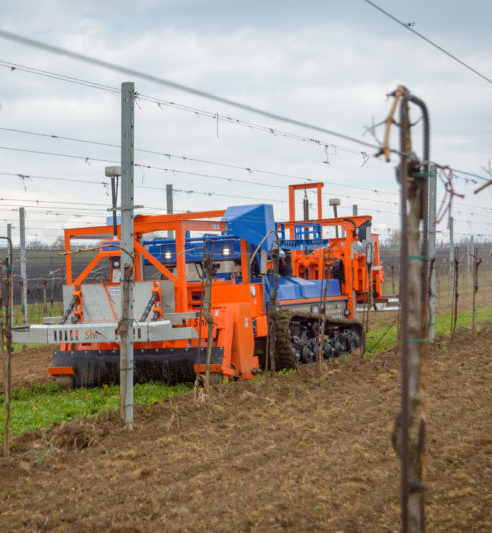The vineyard robot „Slopehelper“ from the company PeK Automotive was intensively tested during a roadshow in late summer and autumn 2022. We’ve been eagerly awaiting feedback from users, and now the results are in:
Some time has passed since the first demo of the vineyard robot “Slopehelper” in Austria in May 2022 – which was organised by the AIL, RWA and the Wein- & Obstbaucenter Langenlois. Following the demo, the AIL joined the five participating vineyards and the dedicated team from PeK Automotive in organising a roadshow through Lower Austria between July and October 2022.
During this time, professional winemakers were able to gain practical experience with the platform and to test winemaking equipment including mulchers and understock clearers. Feedback was collected in the form of interviews and this provided an overview of the opinions of potential users.

This feedback from the winemakers varied considerably depending upon their individual requirements for an autonomous system and on the specific working tools. However, certain aspects were widely rated as very important.
Usability
The size and weight of the robot were rated as suitable for use in vineyards. The safety system of the device also scored very highly. Most of the vineyards were positively surprised by the quiet operation of the electric motor and special praise was also given to the orientation to the rows of vines and the working quality of the mulcher. In contrast, the design of the turning process was regarded as still requiring improvement, largely due to the damage to the ground and the turning space required by the caterpillar drive. However, this was partly remedied in the course of the test by fine-tuning the movements of the robot during the turning process. As the name suggests, the “Slopehelper” is primarily designed for steep slopes. Generally flat vineyards can also envisage using a carrier platform with four wheels instead of a crawler. The mobile RTK-GNSS base station that is required in order to use the system and has to be set up by the farmers themselves was considered impractical. According to the roadshow participants, the following equipment is currently of particular interest to their establishments:
- Mulcher
- Soil cultivation equipment and understock clearers
- Cane cleaning equipment
It was also considered particularly important that the equipment should work on both sides in order to ensure that only one journey is required along each row of vines.
Essential improvements
The following four improvements were identified as essential in order to guarantee the economic use of the “Slopehelper”:
The robustness of the navigation should be increased, both between the rows of vines and at the headland.
- The design of the headland turning operation should be improved.
- The company offers a variety of compatible tools. The development status of each individual tool should be assessed differently. Some – such as the mulcher – are already very well suited for practical use and deliver very good results. Others still require improvement in terms of conception, design and construction. A further option that should also be considered is the creation of a standard pick-up for integrating tools and equipment from established third-party suppliers.
- One particularly critical issue is the autonomous navigation of the device between plots along secondary routes such as farm tracks. Due to the legal uncertainties regarding autonomous driving, this topic is still rarely addressed by robotics companies at the technical level. For users, however, such a capability is central to the economic use of autonomous systems in agriculture, especially in small-scale contexts.
Most farms can envisage using such systems on their farm on a hire purchase basis – as long as these essential improvements to the system have been made. The main arguments in favour of automating activities in the vineyard are the potential reductions in both working time and cost.
Conclusion
One precondition for the widescale adoption of autonomous systems in winemaking is the ability to navigate from plot to plot along secondary routes such as farm tracks. This is both a legal and technical challenge but a solution would enormously increase the uptake of such systems. Despite this, however, it is clear that autonomous systems will eventually become established in winemaking.
Together with its partner network, the AIL aims to contribute to achieving this goal and will continue to devote itself to this and other issues as part of its ongoing cooperation with the company PeK Automotive.
Photo: (c) RWA, Robert Gebauer
